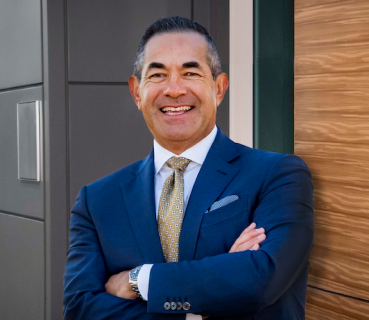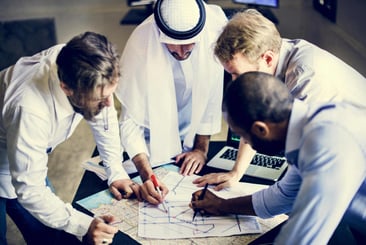Relevant Contents
Need Tailored Business Continuity Insights?
Contact Us Now for Personalized Guidance!
The Middle East is known for its ancient history and present-day turmoil. An ongoing engagement with a client there provides a window into the future of the evolving global threat landscape—and the best ways to mitigate it.
[Related on MHA Consulting: Weathering the Storm: Achieving Resilience in an Age of Extreme Weather]
A Glimpse of the Future in an Ancient Land
The engagement was one of the most interesting we’ve ever undertaken. Businesses in the Middle East operate in one of the most challenging environments to be found anywhere. Being hired to help a global company there improve its resilience was both an honor and an opportunity. It was a vote of confidence in our firm by a group of people for whom severe challenges are an everyday reality. It was also a chance to put our ideas and methodologies to the test in an unusually harsh environment.
Doing Business in a Fierce Environment
An early task in the engagement was to assess the current state of the company’s operational resilience (OR). As usual, we looked at resilience across the areas of people, processes, facilities, technology, and suppliers. So far, so ordinary. Less ordinary were some of the threats the company faced. For example, in looking at reasons people might not be able to come to work, we had to consider the possibility of their neighborhoods being bombed. In assessing threats to their supply chain, we had to consider something that had actually happened: a critical vendor in another country in the region dropping them over political differences.
To top things off, the country was widely considered to be overdue for a major earthquake, not having experienced one since 1927.
An Unflinching Acceptance of Reality
In working with the company, I not only shared my knowledge, I also learned a great deal while seeing much to admire. I learned what it’s like to have to go to work carrying a helmet and bulletproof vest. I admired the skill of their corporate security and cyber security teams and the people’s focused, determined attitude.
Company staff were kind but to the point, with a strong commitment to getting things done and not wasting time. There was also an unflinching acceptance of reality: Yes, making the company resilient will be challenging, but it must be done so let’s get on with it, was the attitude.
Marrying Operational Resilience and Business Continuity
What impressed me most was the client’s swift comprehension of the need to marry operational resilience and business continuity. They understood that it wasn’t enough to try to ensure their operations could continue under pressure (OR), they also had to develop plans and strategies to enable them to recover their critical business and IT processes (BC) in the event things broke down despite everyone’s best efforts. This approach provides a useful model for companies everywhere, as I’ll explain below.
With the current state assessment done, we are now working with the client to develop and implement a road map of scheduled future actions. This will allow the company to convert its dedication and realism into a more secure future for the organization and its stakeholders. By improving resilience across people, processes, facilities, technology, and suppliers, the company will ensure that no matter what disruptions arise it will be able to continue operating or recover quickly.
A Window Into Our Future
You might be asking yourself what this client’s experience has to do with companies in comparatively stable parts of the world, such as the U.S. I believe it amounts to a glimpse of the future.
If current trends continue, the degree of pressure that our client is facing today will be commonly felt in other countries tomorrow. The specific threats will be different, but challenges are mounting almost everywhere. Certainly, the risks for companies globally are on the rise thanks to such well-publicized events as the increase in extreme weather, flaring up of world tensions, and other headline items. Indeed, judging by such recent events as the storms in Florida and North Carolina, the dockworkers’ strike at East Coast ports, and the record-setting heat wave in my city of Phoenix, the future is now in terms of the heightened threats facing U.S. companies.
In this light, our Middle Eastern client’s experience sudden appears widely relevant.
Equally relevant, as well as instructive, are the ways the company responded to the challenges it faced: with realism, determination, and a refusal to waste time. They also realized the necessity of marrying operational resilience with business continuity to ensure they could thrive no matter what the environment threw at them.
An Instructive Example for Companies Everywhere
The challenges faced by a company in the Middle East might seem distant to organizations in less troubled parts of the world. But as risks rise globally, this client’s experience can be seen as a window on the future for companies everywhere.
Our client is safeguarding its future by employing a mentally tough attitude, facing challenges squarely, and integrating operational resilience and business continuity. As threats intensify globally, this approach provides an example for companies everywhere.
Further Reading
- What’s Up, Doc? When and How to Perform a Current State Assessment
- Global Turmoil Making You Ill? Try a Dose of Risk Management
- Weathering the Storm: Achieving Resilience in an Age of Extreme Weather
- Risk Assessment: The Best Way to Identify Your Biggest Threats
- Weird Weather: How to Be Resilient In a Time of Climate Chaos

Michael Herrera
Michael Herrera is the Chief Executive Officer (CEO) of MHA. In his role, Michael provides global leadership to the entire set of industry practices and horizontal capabilities within MHA. Under his leadership, MHA has become a leading provider of Business Continuity and Disaster Recovery services to organizations on a global level. He is also the founder of BCMMETRICS, a leading cloud based tool designed to assess business continuity compliance and residual risk. Michael is a well-known and sought after speaker on Business Continuity issues at local and national contingency planner chapter meetings and conferences. Prior to founding MHA, he was a Regional VP for Bank of America, where he was responsible for Business Continuity across the southwest region.


